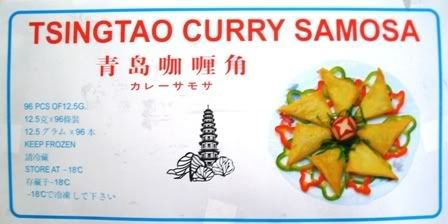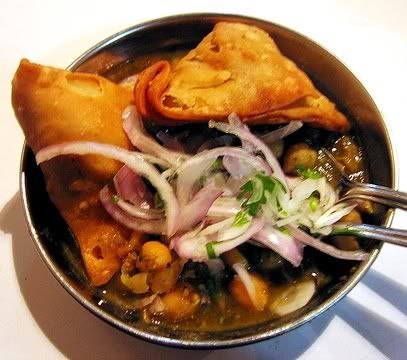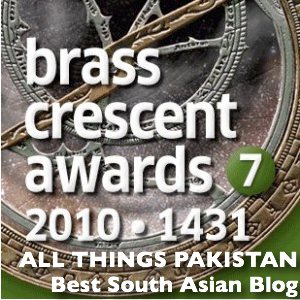 ATP is always searching for tips on good Pakistani food (see here), and as I have a long history with food experiments myself (see here). So here is my new discovery.
ATP is always searching for tips on good Pakistani food (see here), and as I have a long history with food experiments myself (see here). So here is my new discovery.
On our last trip to buy oriental grocery we were surprised beyond words to find ‘Tsingtao Curry Samosa‘ and ‘Paratha – which taste like authentic Indian’ in a refrigerator.
Both of these items were made in China. We immediately bought both items and I must confess they both tasted very good. Samosa filling was made of Chinese curry and Parathas were puff Parathas. You gotta taste them to believe me.
 Today I couldn’t resist and took these photos of ‘made in China’ samosa box to share with all of you.
Today I couldn’t resist and took these photos of ‘made in China’ samosa box to share with all of you.
For those who are really interested in knowing the recipe’ of this Chinese samosa, here are the ingredients which I am faithfully copying from the box:
Cabbage, Wheat Flour, Water, Potato, Mushroom, Onion, Carrot, Vegetable Oil, Sugar, Salt, Soy Sauce and Curry powder.
I believe there is a big food export business going on between China and South Asia. On a trip to China in 2001, I met a businessman from Mumbai who was manufacturing ‘Chinese dumplings’ in India and exporting them to China.
 Now after writing all this I must also state that – with all due respect to China or India – no one can beat the taste of Samosas sold in United Bakery, Karimabad Chowrangi Karachi.
Now after writing all this I must also state that – with all due respect to China or India – no one can beat the taste of Samosas sold in United Bakery, Karimabad Chowrangi Karachi.
As the poet says:
jo maza chajjoo de chobaaray
O na Balkh na Bukhaaray
The enjoyment that one gets on a native street corner
cannot be found in either Balkh or Bukhara




















































Sridhar, thanks for taking us to a culinary tour of delhi. i hope i get to visit it someday soon and i do believe the samosas and paratha there are as good as you said. Many dishes in Pakistan owe their origin to Delhi area
Saadia, thanks for taking time out and writing a thoughtful piece on low cost manufacturing. This is indeed a challenge and a lot needs to be learned from how the Chinese are able to do it.
@Sridhar
Multan’s Sohan Halwa is very famous all over Pakistan !!!
@ Sridhar: Thanks for the delectable details. I can say that would be a treasure hunt visiting those lanes as one can unwrapp flavors, histroy, and pleasure!
Sridhar, What else could one write after your line below.
Intoxicating!
“You can find sweets of that quality elsewhere, but not the feeling that comes from the realization that Ghalib, on his way to the Red Fort from his house would have passed this shop and perhaps even bought sweets there.”
Chinese products are every where. They are cheap and good in quality and thats why we all buy them. Samosa is a small but very good example of Chinese production. They Chinese at the product and copy it. And at very next day they can produce it and bring it to international market. As buyer one does not really need to struggle for a good price. Chinese as seller knows how to bring the price to your desire. Try Alibaba.com you will see how they will beat the selling price of your local manufacturer. There is one example of Tchibo a German fast growing company, founded in Hamburg in 1949 as a direct mail company selling roasted coffee. Now Tchibo is one of Germany’s biggest international consumer goods and retail companies with over 60,000 outlets worldwide. The demands of Tchibo proucts were so high that they had to make establish a seperate logistic company called Tchibo Logistics GmbH. In 2003, Tchibo inaugurated Europe’s largest warehouse, where over 6,000 goods pallets are handled every day.Probably its small example for US but for Europe its something very extra ordinary. I would say if there was no Chinese growth many consumer goods companies would not grow the way they have in last 5-6 years (it can be other way round too).But infact the success of Tchibo is also in hands of Chinese products. At very small scale Tchibo does buy a products from Bangladesh, Egypt, Vietnam and countries like Pakistan is not in Tchibo’s list. Atleast when I was working there I did not find the Pakistan or even India on their list. One Buyer in Tchibo told me that its all about price and now China is producing good quality products as well so she would not consider Indian or Pakistani products.
Otto group is another biggest company in Europe, and they were buying alot of textile products from Pakistan but in now they switched to China. Some years back I always found the Pakistan’s made football in many German sports shops. But in time of FIFA world cup 2006 I found every where only the balls from china.
What ever is the reason of their development including low wages to the workers and significant investment in infrastructure and FDI, the Chinese economy is killing the economic growth of many developing countries. Samosa is one of the serious example to show how they have entered in our homes. Its not about Samosa its about all the products we use in our daily life. Its computer about technology like Lenovo (IBM),aircraft like Airbus production in China, Mini buses production and not to surpise they also produce very fine coffee to compete Africa and Latin America. And we do see that products of all sorts will no longer just be made in China but will be branded there too.
Question is what Pakistan can do for its economical growth? Probably you can answer better. My opinion is that Pakistan’s economy will continue to suffer until governmental leaders will not open their eyes to the lesson of China and accelerate the economic reform process. Pakistan should reform in order to attract foreign direct investment. Pakistan also needs to root out the corruption especially in govt. sectors as it will also give a chance to small industries to grow better. Economy can grow if some critical macro and micro initiative are seriously taken, for this govt. (honest)initiaves are needed. China has seen significant investment in infrastructure and FDI, while Pakistan’s economical growth has been without any sensible investment in infrastructure and FDI. There are many factors which play an important role as well but I am leaving the discussion for you as I believe you guys have better arguments and suggestions.